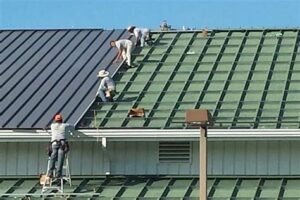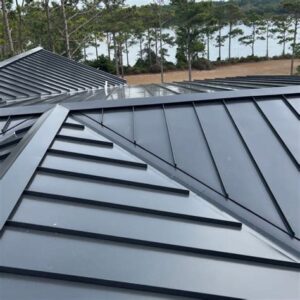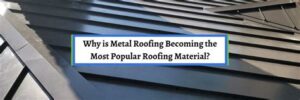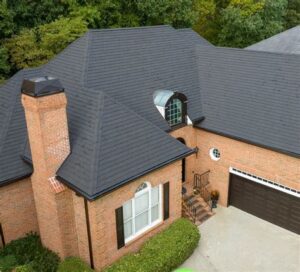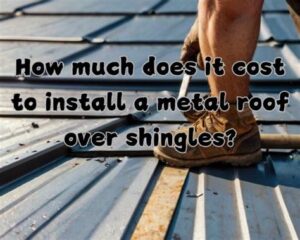Are you considering a flat metal roofing system for your next construction project? You’re in the right place! Metal roofing offers durability, energy efficiency, and an impressive lifespan that can provide substantial benefits for homeowners and builders alike. In this comprehensive guide, we will explore everything you need to know about flat metal roofing materials, highlighting the ultimate choices available on the market today. From key factors to consider when making your purchase to a detailed cost breakdown and essential installation tips, we’ll equip you with all the information needed to make an informed decision. Plus, we’ll share strategies for maintaining your roof’s longevity to protect your investment for years to come. Let’s dive in and discover the ultimate buying guide for flat metal roofing materials!
Understanding Flat Metal Roofing Materials: The Ultimate Choices
When it comes to selecting the right materials for flat metal roofing, you have several options, each with its own set of benefits. Understanding these materials will guide you to make the ultimate decision for your roofing needs.
Here are the most common types of flat metal roofing materials available:
- Steel: Known for its strength and durability, steel is a popular choice. It can be galvanized or coated to resist corrosion. Steel is cost-effective and widely available, making it the go-to option for many homeowners.
- Aluminum: Lightweight and resistant to rust, aluminum is an excellent choice for areas near coastal regions where saltwater exposure is a concern. Additionally, aluminum reflects heat well, contributing to energy efficiency.
- Copper: Although one of the more expensive options, copper roofing offers unparalleled aesthetics and longevity. It develops a beautiful patina over time and is known for its durability, often lasting over 100 years.
- Zinc: Similar to copper, zinc is highly durable and has self-healing properties when scratched. It is an eco-friendly option that can last more than 80 years and is often used in contemporary architectural designs.
- Metal Sheets and Tiles: These come in various profiles, including standing seam and corrugated designs. They offer versatility in terms of visual appeal and function, allowing for a customizable roofing solution that can enhance curb appeal.
When choosing the right flat metal roofing material, consider factors such as climate, budget, and the specific aesthetic you want to achieve. Remember, selecting the ultimate material not only ensures the performance of your roof but also contributes significantly to your property’s value and visual appeal.
Key Factors to Consider When Buying Flat Metal Roofing
When considering flat metal roofing for your property, it’s essential to weigh various factors to ensure you make the best decision. Here are the key factors that can guide you during your purchase:
1. Roofing Material Type: The first step is to determine the type of metal you prefer. Common options include aluminum, steel, and copper. Each material has different properties in terms of durability, aesthetics, and cost, making it crucial to research what best suits your needs.
2. Cost and Budget: Establishing your budget should be a priority. Flat metal roofing comes in various price ranges. Aside from the material cost, consider installation and maintenance expenses, which can significantly affect the overall budget.
3. Climate and Environment: Understanding your local climate is vital when selecting roofing material. For instance, if you live in a region prone to heavy rainfall or snow, you might require a material that offers better resistance to these elements.
4. Energy Efficiency: Flat metal roofs can provide significant energy savings. Look for products with reflective coatings or those that have been designed with energy efficiency in mind, contributing to lower cooling costs.
5. Warranty and Lifespan: Evaluate the warranty provided by manufacturers. A good warranty can indicate a high-quality product. Consider the expected lifespan of the metal roofing as well, as this can affect your long-term investment.
6. Aesthetic Appeal: The look of your roofing matters. Depending on your home’s style, selecting a color and finish that complements your property can enhance curb appeal. Many manufacturers offer a wide range of finishes to match different designs.
7. Installation Requirements: Not all metal roofing requires the same installation process. Ensure you understand the installation requirements of the chosen material and whether you’re hiring professionals or doing it yourself. The complexity can affect overall costs and the durability of the roof.
8. Local Building Codes: Always check local building codes and regulations before purchasing flat metal roofing materials. Compliance with these codes is essential for avoiding future legal issues and ensuring safety.
9. Environmental Impact: Sustainability is becoming increasingly important. Selecting eco-friendly materials that are recyclable can not only help the environment but may also qualify for tax credits or rebates.
10. Maintenance Needs: Different metals require varying levels of upkeep. Investigating the maintenance requirements for the roofing materials you consider will help you anticipate ongoing costs and efforts associated with keeping your roof in top condition.
By keeping these ultimate factors in mind, you can confidently navigate the process of buying flat metal roofing, ensuring that you choose the best option for your property’s specific needs.
The Ultimate Cost Breakdown of Flat Metal Roofing Options
When considering flat metal roofing, understanding the costs associated with different materials is crucial for making an informed decision. Below is a detailed breakdown of the costs you can expect based on various roofing material options and other essential factors.
| Material Type | Average Cost per Square Foot |
|---|---|
| Aluminum | $3.00 – $6.50 |
| Steel | $2.00 – $5.00 |
| Copper | $8.00 – $15.00 |
| Zinc | $5.00 – $10.00 |
In addition to the material costs, other factors contribute to the overall pricing of flat metal roofing:
- Labor Costs: Depending on your location, labor fees can vary significantly but typically range from $1.50 to $3.00 per square foot.
- Roof Size: The larger the area, the higher the overall cost. Metal roofing materials are usually sold by the square foot.
- Complexity of Installation: Roofs with multiple angles, skylights, or intricate designs may incur additional labor costs.
- Accessories and Underlayment: Don’t forget to factor in the costs of flashing, insulation, and other necessary accessories, which can add up.
Investing in flat metal roofing has its financial implications, but it’s important to view this as a long-term investment. The durability and low maintenance requirements often result in savings over time. By planning your budget and understanding the associated costs, you can make a more informed decision that aligns with your project’s needs and your budget.
Installation Tips for Achieving The Ultimate Flat Metal Roof
When it comes to achieving The Ultimate installation for your flat metal roofing, careful preparation and attention to detail are key. Here are some essential tips to ensure a successful installation:
- Choose the Right Materials: Ensure that the metal panels and accessories are suited for flat roofing applications. Opt for materials with high resistance to corrosion and weather damage.
- Proper Insulation: Use appropriate insulation materials underneath the metal panels. This not only enhances energy efficiency but also prevents condensation issues.
- Install a Slope: Although flat roofs are referred to as ‘flat’, a slight slope is crucial for water drainage. Aim for at least a 1-2% slope to prevent standing water.
- Use Quality Sealants: Apply high-quality sealants around penetrations and seams to ensure a watertight installation. This is vital for preventing leaks and enhancing ultimate durability.
- Follow Manufacturer Recommendations: Adhere strictly to the installation guidelines provided by the metal roofing manufacturer. This ensures compliance with warranty and performance expectations.
- Check Local Building Codes: Before installation begins, consult local building codes to ensure compliance. This helps avoid issues with inspections or permits later on.
- Utilize Proper Safety Gear: Always prioritize safety when working on roofing projects. Use safety harnesses, hard hats, and non-slip footwear to prevent accidents.
- Regular Inspections: After installation, schedule periodic inspections to check for any signs of wear and tear, ensuring your flat metal roof continues to meet the ultimate standards.
By implementing these tips during installation, you can achieve a flat metal roof that not only looks great but also stands the test of time, providing the ultimate protection for your building.
Maintenance Strategies for The Ultimate Longevity of Your Roofing
Maintaining your flat metal roofing is crucial for ensuring its durability and extending its lifespan. Here are some ultimate strategies to effectively care for your roofing materials:
- Regular Inspections: Conduct inspections at least twice a year, preferably in spring and fall. Look for signs of rust, damage, or loose seams.
- Clean the Surface: Remove debris, leaves, and dirt regularly to prevent moisture buildup that can lead to corrosion. Use a mild detergent and soft brush to clean stubborn spots.
- Check for Leaks: After heavy rain or snow, inspect your roofing for leaks or water pooling. Address any issues immediately to avoid extensive damage.
- Touch Up Paint: If your roofing material is painted, check for areas where the paint has chipped or faded. Repaint these sections to maintain protection from the elements.
- Seal Joints and Flashing: Ensure that all seams, joints, and flashing are sealed properly. Use quality sealants to prevent moisture infiltration.
Consider scheduling a professional maintenance check every few years for a comprehensive assessment. Their expertise can help identify potential problems you might miss.
By following these ultimate maintenance strategies, you can significantly enhance the longevity of your flat metal roofing and protect your investment for years to come.
Frequently Asked Questions
What are the advantages of using flat metal roofing materials?
Flat metal roofing materials are durable, lightweight, and resistant to extreme weather conditions. They also reflect heat, which can lead to energy savings.
What types of metal are commonly used for flat roofing?
Common metals used for flat roofing include aluminum, steel, and copper. Each material offers its own benefits in terms of cost, durability, and aesthetics.
How does the cost of flat metal roofing compare to other roofing materials?
While the initial cost of flat metal roofing may be higher than some traditional materials, its longevity and lower maintenance requirements can result in cost savings over time.
What factors should be considered when choosing flat metal roofing materials?
Consider factors such as local climate, building design, budget, and the specific characteristics of different metal types to determine the best option for your needs.
Is flat metal roofing suitable for all types of buildings?
Flat metal roofing can be suitable for many building types, including commercial and residential structures. However, it’s essential to consult a roofing professional to assess compatibility.
What maintenance is required for flat metal roofing?
Regular maintenance includes cleaning debris, inspecting for rust or corrosion, and ensuring that drainage systems are functional. These practices help prolong the lifespan of the roofing.
Can flat metal roofing be installed over existing roofing materials?
In many cases, flat metal roofing can be installed over existing roofs, provided the underlying material is structurally sound. Consulting with a roofing expert will help determine the best approach.
